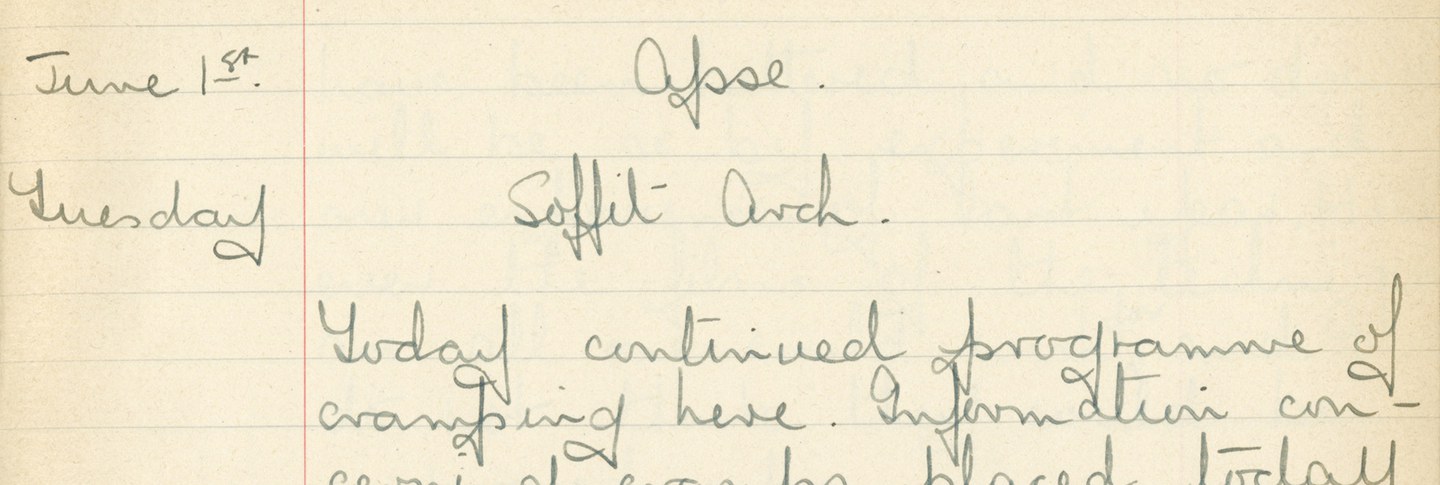Correspondence in the The Byzantine Institute and Dumbarton Oaks Fieldwork Records and Papers at ICFA and the Fonds Thomas Whittemore at the Bibliothèque Byzantine at the Collège de France in Paris adds another important layer of information that clarifies the use and purpose of these moving images. Letters illustrate the reactions of the audiences in Europe and the United States after viewing the Byzantine Institute’s films, as well as requests for Thomas Whittemore to present them to additional audiences. From the extant correspondence, it is difficult to discern the purpose of the film made at the Red Sea Monasteries and there is no evidence of it being shown publicly.
However, the purpose of the Hagia Sophia is clearer. All of the moving images from 1936 on were produced by Pierre Iskender. They have a professional character, displaying the splendid colors of the mosaics and the techniques employed by the Byzantine Institute to restore them. William John Gregory’s notebook entry upon seeing the first Iskender film is a vivid document of the fieldworkers' expectation that the films were a truthful document of color and technique.
Once recorded, Thomas Whittemore presented the finished films to the public, both on their own and to illustrate his many lectures on Hagia Sophia. Whittemore made wide use of the moving images, showing them privately to donors and patrons, such as Robert Woods and Mildred Bliss, to Byzantine specialists and the broader scholarly community, and to an interested general audience. The films seem to have been a powerful tool to raise funds for the work of the Byzantine Institute. The screenings of the Hagia Sophia films were so popular that Whittemore was asked on several occasions to organize a special viewings especially for the Blisses and for the community at Dumbarton Oaks.
The last evidence of a planned screening involving Whittemore is a letter confirming his participation in the annual meeting of the American Philosophical Society in 1951. Unfortunately, Whittemore passed away unexpectedly in June 1950. After his death, interest in the moving images of the mosaics in Hagia Sophia and Kariye Camii began to fade. The correspondence documents only two additional screenings in 1951. The first was requested by an art history professor at Mount Holyoke College, Whittemore’s former student, who hoped that the film would inspire her students to take an interest in Byzantine art. The second was a special screening at the Fogg Art Museum at Harvard University, in honor of Whittemore and his accomplishments.
Exhibit Items
Connick, a leading American stained glass artist of the first half of the 20th century, expresses his amazement upon seeing a film of the mosaics of Hagia Sophia.
Gregory expresses his opinion upon seeing the films shot in 1936 for the first time the following year.
Arne extends an invitation for Whittemore to give two lectures illustrated with films in Sweden.
Roosval expresses how delighted he is that Whittemore will be visiting Stockholm and Upsala to give lectures illustrated with the film.
Bliss expresses her apprehension regarding Whittemore's return to Istanbul, suggesting that he should instead travel around the United States to show "the film" since many people were interested in seeing it.
Whittemore expresses his interest in publishing the uncovered mosaics in Hagia Sophia as soon as possible to prevent German intervention. He discusses publicizing the work of the Byzantine Institute on the West Coast by giving a lecture illustrated with the color films.
Whittemore informs Thacher, Director of Dumbarton Oaks, that he has agreed to show a color film of the work carried out at Hagia Sophia, in response to a request from the Administrative Committee of Dumbarton Oaks.
Whittemore agrees to show color films of the work done at Hagia Sophia at Dumbarton Oaks.
Whittemore proposes a lecture at the University of Rochester, which will be illustrated with color films of the conservation work carried out in Hagia Sophia.
Clark from the Eastman Kodak Company invites Whittemore to give a public lecture illustrated with the color film at the Art Gallery in Rochester, NY.
Thacher, Director of Dumbarton Oaks, asks Whittemore to give a public lecture with films at Dumbarton Oaks.
This short summary published in the proceedings of the 6th Congrès International des Études Byzantines shows that Whittemore presented the work of the Byzantine Institute to the Byzantine scholarly community by means of the color films produced during the cleaning and restoration work at Hagia Sophia.
The Executive Officer of the Society informs Whittemore that a screening of the films at the Annual Meeting in 1950 would not be possible, but proposes to put him on the program for the following year.
Whittemore agrees to show the color film at the American Philosophical Society Annual Meeting in 1951. This screening never took place as Whittemore passed away on June 8, 1950.
Coolidge from the Fogg Art Museum at Harvard University accepts MacDonald's offer for a screening of the Byzantine Institute films.
Marian Hayes, art history professor at Mount Holyoke College and a former student of Whittemore's at New York University, inquires about renting the color film on Hagia Sophia to show it to her students.
The Byzantine Institute issues an invitation to a screening of the films in honor of Thomas Whittemore at the Fogg Art Museum at Harvard University.
MacDonald replies to Hayes' inquiry about renting the films by explaining that they are unique and thus cannot be lent out. Instead, MacDonald proposes that he personally transport the films to Mount Holyoke College for a screening.


















